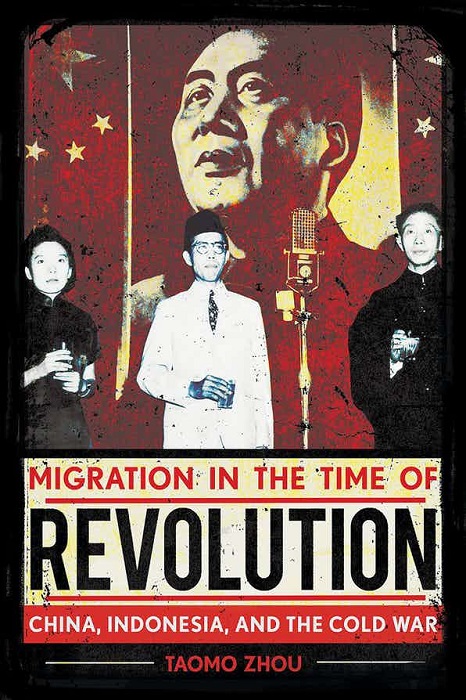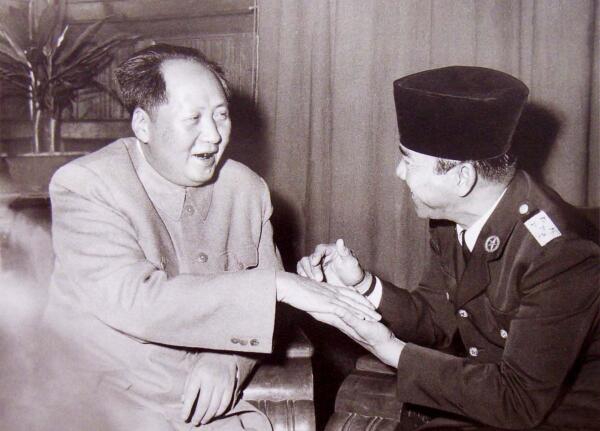Bernard Z. Keo
Much like the process of migration itself, Zhou’s magisterial monograph takes readers on a transnational journey between China and Indonesia as it explores the ties – and people – that bind. Through the lens of both the state and the individual, Migration in the Time of Revolution explores how ethnic Chinese from Indonesia played a critical role in the burgeoning relationship between Jakarta and Beijing from 1945 to 1967.
Zhou has produced a stunning synthesis of migration and diplomatic history to demonstrate how international diplomacy is deeply intertwined with the global movement of peoples across borders. Specifically, the book sheds light on overseas Chinese mobility, explores how bilateral relations could be facilitated and undermined by ‘ordinary’ actors on the ground in both Indonesia and China, and reveals a new dimension to the Cold War in Southeast Asia by shifting the focus away from the ‘hot’ wars that tend to draw scholarly attention.
The book utilises a vast array of primary source material including archival records from the People’s Republic of China (PRC), the Republic of China (ROC), and Indonesia; other written material from the PRC, Hong Kong, Indonesia, and the Netherlands; and oral history interviews. Of particular note is Zhou’s serendipitous access to now-reclassified files of the Chinese Foreign Ministry. The richness of this archive is perhaps best exemplified in a transcript of a 1965 conversation between Mao Zedong and Chairul Saleh, the speaker of the Indonesian Provisional People’s Consultative Assembly where Mao encouraged Indonesia to develop its own nuclear weaponry. Wonderful anecdotes such as these intersperse the book and add a great degree of texture to the broader narrative. However, all credit is due to Zhou for her detailed and compelling analysis of these sources, which are combined with a critical eye (and ear) towards personal recollections recorded from a diverse cast of characters ranging from PRC diplomats to ‘ordinary’ migrants.
Zhou’s work is by necessity transnational, not just in its analysis of both China and Indonesia’s Cold War connections but by virtue of her protagonists. The Chinese of Indonesia, as part of a broader if somewhat inelegant category of the overseas Chinese, have historically been perceived as occupying a space between their ‘homes’. In the eyes of successive states in Southeast Asia (be they colonial or nation), ethnic Chinese communities have long been suspect for their alleged unbreakable bond with their ‘homeland’ of China. Yet, ethnic Chinese have played an important if precarious role in the region, serving as ‘essential outsiders’ that facilitated the making of modern Southeast Asia.

In the first two chapters, readers are provided with a comprehensive map of the complex interactions between ethnic Chinese in Indonesia with the Kuomintang (KMT) and the Chinese Communist Party (CCP). Zhou demonstrates how the question of citizenship – specifically the incompatibility between jus sanguinis (right of blood) practiced by the KMT and jus soli (right of soil) practiced by the fledgling Republic of Indonesia – precipitated a clash between Chinese Nationalists and Indonesian Republicans. This was a conflict exacerbated by the KMT’s refusal to recognise an independent Indonesia, siding instead with its wartime ally, the Netherlands. In contrast, the CCP operated clandestinely, developing its base in Indonesia through education and publishing. With the outbreak of the revolution, the CCP and its Indonesian affiliates professed solidarity with the Republic of Indonesia and attempted to counteract the actions of those Chinese that sided with the Nationalists and, by extension, the Dutch.
Chapter 3 picks up the action in the wake of the establishment of the PRC and the ROC, examining how with roles reversed, the two countries switched approaches. While the former—having received formal diplomatic recognition from Indonesia in 1950—prioritised inter-state diplomacy, the latter focused on developing interpersonal connections with conservative Indonesian elements. Taipei initially had the upper hand due to the presence of strong anti-communist elements in the first Indonesian cabinet and Beijing’s adherence to exporting revolutionary communism. As Zhou argues however, Indonesia’s shift to the left over the course of the 1950s and Beijing’s reinvention of its international image as a major force in the politics of Afro-Asian solidarity following the Bandung Conference of 1955 tipped the scale towards the People’s Republic.
The subsequent three chapters examine how this battle between the two Chinas was reflected in Indonesia with pro-Beijing and pro-Taipei groups waging war over print and visual media, social and cultural organisations, and schools—and the ramifications this had. Alarmed by the escalating conflict between the ‘Reds’ and ‘Blues’, pribumi elites developed a regime of surveillance and control over ethnic Chinese on the basis of securing Indonesia’s domestic and international interests. Such actions stemmed from rising anti-Chinese sentiment over their cultural distinctiveness, economic dominance, and perceptions that events involving the ethnic Chinese were products of PRC interference.
The anxieties of the pribumi officials regarding the Chinese as a fifth column for the CCP did not reflect the reality of the situation, nevertheless had very real consequences. Of particular note was the attempted ‘Indonesianisation’ of the economy through large-scale seizures of Chinese businesses. This precipitated a mass exodus of approximately 102,000 Chinese from Indonesia to the PRC over the course of 1959-1960. Despite their dissatisfaction, Beijing prioritised maintaining its relationship with Jakarta over intervening on behalf of the Chinese in Indonesia. Unhappy with the PRC’s position, ethnic Chinese in Indonesia did not sit idly by and applied pressure on PRC diplomats to offer protection or repatriation. The situation de-escalated over the course of 1960 as Sukarno realised the necessity of the Chinese in the domestic economy as well as the benefits of PRC support in the international arena.
Sensing an opportunity, Beijing took to engaging Sukarno, which resulted in the deepening of relations between the Indonesia and the PRC, the subject of Chapter 7. As their domestic and foreign policies converged, Beijing and Jakarta forged what Zhou aptly calls ‘a dangerously intimate bond’, collaborating on Afro-Asian projects such as the Games of the New Emerging Forces (an alternative to the Olympic Games), the second Afro-Asian Conference, and the Conference of the New Emerging Forces. In the early 1960s, Beijing and Jakarta united on the issue of anti-colonial struggle with the People’s Republic supporting Konfrontasi (the Indonesian-Malaysian Confrontation) due to mutually shared perceptions of Malaysia as a neo-colonial anti-communist invention designed to threaten both countries. However, Zhou suggests that this alliance was steadily undermined by rising anti-Chinese sentiment in Indonesia, PRC fears of stoking ethnic conflict if they were to mobilise the Chinese across Southeast Asia in support of Konfrontasi, ambivalence towards Sukarno’s expansionist desires, and Jakarta’s flirtations with opportunistic Yugoslavia-inspired non-alignment.
Chapters 8 and 9 explore how the PRC’s relationship with Indonesia changed following the overthrow of Sukarno and his replacement by Suharto and the New Order. Importantly, Zhou deploys previously unseen evidence to demonstrate that the PRC had a limited role in the 30th of September Movement (Gerakan 30 September, G30S), the abortive coup d’etat of 1965. Specifically, she debunks long-held assumptions that China helped engineer G30S in order to foment a full-scale communist revolution, arguing instead that Beijing intended to reinforce Sukarno’s position and had no involvement in the planning or execution of the attempted coup. Following the rise of the anti-communist Suharto and the New Order after G30S, Jakarta’s relationship with Beijing soured as the former resorted to anti-Chinese and anti-communist policies and actions while the latter swung towards the radical left in the wake of the Cultural Revolution. This resulted in a diplomatic freeze in 1967 which was seized by Taipei, seeking to reconnect with the substantial Chinese population in Indonesia and to open up Indonesia as a potential market for Taiwanese goods. In response to escalating anti-Chinese violence in Indonesia under Suharto, the two Chinas adopted starkly contrasting responses. While Taipei described the violence as collateral damage resulting from the PRC’s expansionist tendencies, Beijing delivered scathing indictments of ‘reactionaries’ in the Indonesian government and assisted the repatriation of fleeing ethnic Chinese.
The final chapter explores this ‘homecoming’ and the contestations that took place regarding their place in a society both foreign and familiar. Primarily consisting of bourgeois elements, the integration of these ‘returnees’ into a completely different politico-economic environment proved challenging. However, as Zhou demonstrates, the capitalist skills that many of these migrants had and their transnational family connections which made them suspicious in the eyes of the CCP in the 1950s and 1960s would prove to be valuable assets following the rise of Deng Xiaoping and China’s opening up to the world. The stories told here of the migrants’ experiences and their efforts at first resisting and then adapting to the socialist way of life are the highlight of the book and deserve a full reading rather than a summary that would do them little justice.
At the end of the book’s – and our – journey, we are left to ponder what next for China and Indonesia. As Zhou has convincingly shown, in light of their recent history, the ethnic Chinese of Indonesia will be vital in this complex and dynamic relationship, being shaped by as well as shaping how these countries interact. In light of the One Belt, One Road initiative and tensions between China and its neighbours over the South China Sea, it is more important than ever to understand and reassess China’s relationship with Southeast Asia. Migration in the Time of Revolution is a timely and valuable study, providing important insights into China’s historical relationship with one of the most influential countries in Southeast Asia.
Taomo Zhou. Migration in the Time of Revolution: China, Indonesia, and the Cold War. Ithaca and London: Cornell University Press, 2019.
Bernard Z. Keo (bernard.keo@monash.edu) is a PhD Candidate at Monash University.
